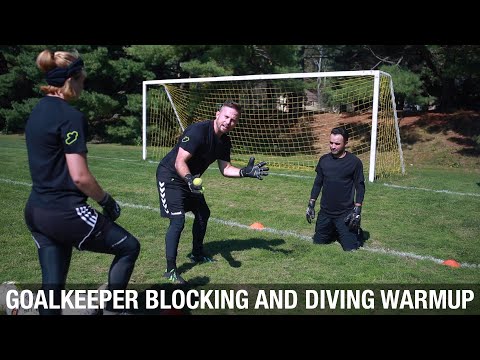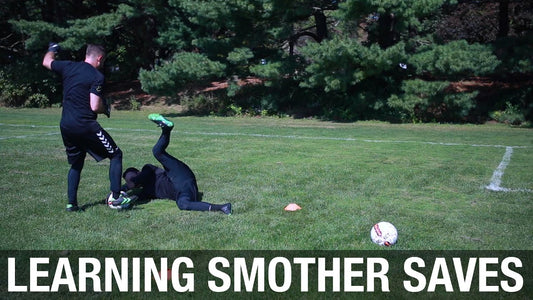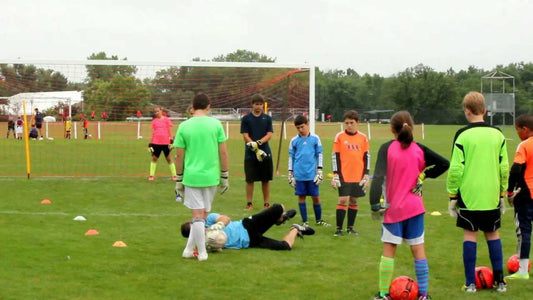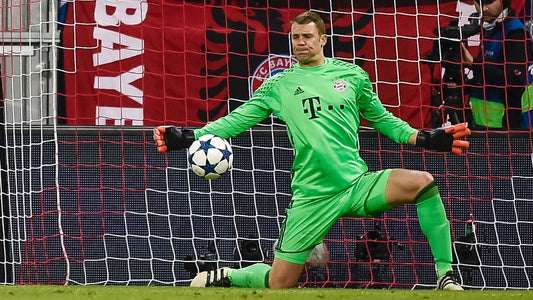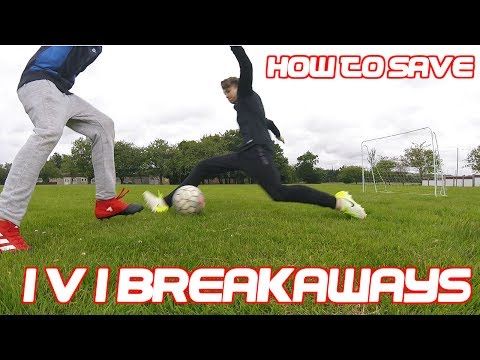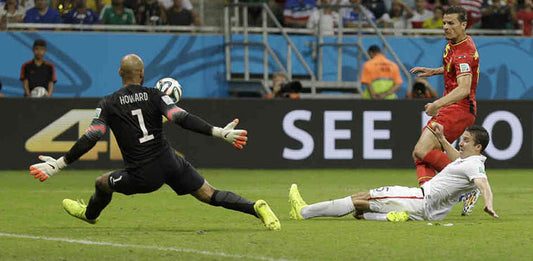The breakaway save is a tough technique to learn for a soccer goalie. Timing and bravery are key aspects of making this type of save at the strikers feet. Some call it a 50-50 with the striker, some say it's a 1v1 save. At the end of the day, you're putting your body on the line to make the save. Putting your head and hands where it hurts. It's important to learn the correct technique to protect yourself and the soccer ball.
Breakaway Situations
Goalie Drills For Blocking and Diving
Breakaway Saves
One on One Situations - When To Win and When To Block?
The soccer penalty box is busy these days with strikers and defenders. The opportunity and decision to save or attack a free ball can be milliseconds. These Youtube goalkeeper training drills are warm up activities to help the goalie develop coordination to activate the hands, body, and feet. To stay balanced and ready to make the decision to dive for a ball or stay up and patient to block a shot. To encourage bravery within youth and developing goalkeepers on 50/50 and smother saves.
Definitions: Block - create a barrier to block a shot. Hands, body, and feet can all make the save. Harder shots closer to the feet can be saved by the feet. High shots can be saves by body or the hands. Blocking doesn't have to be at the point of the shot. Blocking can be utilized from 1 to 5 yards when the shot is hard and the hands don't have enough time to control the save. Smother Save - The point when a shooter and goalkeeper are both arriving at the ball at the same time. 50/50 ball. Goalkeepers dive at the shooter's feet, shooting their hands too and through the ball, driving the arms at the ball to "smother" the save on the striker's foot or body with the goalkeepers core muscles and momentum. A type of breakaway one on one save. Attack and Win - Recognize the ball is free in space off of a pass or touch. Take the necessary action employing a variety of techniques to gain control of the ball or deflect out of danger.
Progressions:
Activating hands and feet from knees: Set Up: cones 3-4 feeat apart depending on the size of the goalkeeper. 2 soccer balls. Handful of tennis balls. Goalkeeper coach or servier 4 feet away. Accuracy of speed of service is important. Idea is to increase coordination of hands, feet, and body. Services can build as comfort level and familiarity build.
Balanced neutral ready position. Hands in front wider than body. Hands and feet are in play. Stay up as long as possible.
Tennis ball toss to develop hand eye coordination. Feet and hands come up together to create a larger blocking area.
Active hands and feet. Concave body shape.
Shots at feet - block with leg or foot.
10 services with tennis ball or soccer ball each side. 2 X each side
Blocking and Diving Warm Up: Time - 1:30
Set Up: Two target areas. 3 - 4 feet depending on size and age of goalkeeper for the harder down the middle shot. 1-2 feet side channel for 50% services for diving saves. Cone distances are for accuracy of service as well as for the goalkeepers to visually see the range they can cover with each technique. 6 to 8 services each side. Build timing and confidence of the goalkeeper by starting with one side. Harder services to challenge the technique on each side. Goalkeeper coach or server can build from the simpler single sided service to decisions and reactions on either side.
Neutral and balanced to react to service.
Hands wider than body width with bent arms.
Active hands and feet for harder shots down the middle. Services should be hard and close enough not too allow the goalkeeper to simply scope.
Quick step to position body weight effectively drive hands, head, and body laterally for diving save.
Don’t guess react with a dive or a block.
Try not to fall back.
3rd Decision, Ball In Space - 3:15Incorporate a pass into space for the goalkeeper to recognize the loss of control, big touch, or pass. If the goalkeeper can attack the ball and win it in space than make the quick decision and go for it. Now there are three techniques to use the decisions and reactions of the goalkeeper may be slower. With repetition the speed of decisions and reactions will increase. Increase the speed and deception with the goalkeeper's comfort level.
Special Thanks for Storelli Sports Goalkeeper equipment and protection as well as Hami from HK_Goalkeeping_1.
Contact keeperstop.com in the USA for goalkeeper equipment and education, training drills, or camps.
Soccer Goalkeeper Drills For Breakaway Saves
Soccer goalie drills to help a goalkeeper's timing and build courage on breakaway saves. The goalkeeper training begins with a through ball and the Before save. The before save is before the field player has a chance to gain control again. Varying through balls are introduced with pressure for the goalkeeper to make decisions such as when to come out; what technique to win the ball; or when to reduce the angle for a shot save. The second goal keeper training drill highlights the technique of stalking while the attacker has the ball under control dribbling towards goal. The Keeperstop.com goalkeeper training ends with a fun 2v2 game where goalkeepers have to problem solve, employ breakaway save techniques, and communicate to a defender to win possession.
Watch the YouTube video of the session HERE!
Goalkeeper breakaway drills with goalie diving technique
Build the timing and courage of your youth goalkeeper with the Breakaway Alley goalkeeper drill. The goalkeepers range in age from 10 -12. Youth goalkeepers love the game since it is a controlled goalkeeper breakaway drill that is fun and challenging way to instill proper low ball diving techniques, timing, and courage with breakaway saves.
Attacking team: 1 point for every goalkeeper they pass.Goalkeeper team: Switch after a set number of saves.
Keep track of the number of times each team stops the attack as well as points. Switch after the team that is goalkeeping stops the attack a specified number of times. I typically do 12-15. Switch teams from attack to goalkeeping. Obviously the goalkeepers in front will receive more action. Move different goalkeepers up front. Repeat to build confidence and proper technique. Let the goalkeepers try the technique out and challenge themselves before stopping. The coaching points that you see in the video are over a 25 minute progression. Contact keeperstop.com with any goalkeeper training questions or for a goalkeeper clinic near you.
CLICK HERE FOR THE VIDEO
Here are the focus areas of the session:Start from knees – helps the youth goalkeeper to concentrate on a few body mechanics at a time.
Ready position with slight bend on the back
Hands in front of body elbows slightly bent
Drive hands and head to the ball to attack the ball
Hands and arm create a window to protect the face
Goalkeepers drive to the ball landing on their side
Counter balance leg (top leg) into the chest area but doesn’t go past 90 degrees for momentum and to protect the goalkeepers stomach.
From the feet: More challenging since it is a longer way from the ball and it is combining the coordination of upper and lower body.
Same Points as above
Lower hand position wider than legs out in front of the body to be ready for a close range low shot.
Be patient
Stay up as long as possible.
Step low into the inside leg closest to the ball. Drive hands and body to the ball. Watch that the ball doesn’t go under the goalkeeper.
Important to focus on the hand and arm positioning to make sure the goalkeepers face is protected from a foot or the ball.
Be courageous. Trust the technique to protect your body and the goal.
Out of your mind breakaway Saves
Teaching breakaways and getting good at breakaways can sometimes be at odds with each other. Often, untrained goalkeepers go flying into breakaways with their hair on fire. They attack the situation wildly and with lots of conviction. But with no technique, they are dead in the water. Alternatively, trained goalkeepers, now armed with a full arsenal of weapons with which to combat breakaways, often lack that conviction, that fierce approach that they once had, because they are now lost in thought and indecision in the face of the live breakaway. The challenge is to give the goalkeepers sophistication while preserving their primal instincts.
When we begin our breakaway sessions at the No.1 Goalkeeper Camp, we often say, “This is the most complex topic of the week. We have loads of information to get through, so let’s stay focused.” And that’s no lie. There is so much that goes into making the breakaway save for the goalkeeper in terms of analyzing the type of breakaway he or she is faced with, choosing the appropriate response to that type of breakaway, executing the extremely difficult technique of sliding and forming a long barrier when appropriate, and – perhaps above all – summoning the courage and conviction to take control and make a save. It is, indeed, a tall order for a young goalkeeper. It can be equally challenging to teach. The experienced staff of Goalkeeper Directors at No.1 each like to present the session in their own way. Mike Potier’s field layout often has young goalkeepers’ angles coned out to train the line the goalkeepers take when closing the striker down. And you’ll hear him yelling “Tiger, Tiger, Tiger, Swan!” (Ok, I guess you have to be there.) Joe Machnik famously teaches part of the session in a circle that reminds me of a gladiator arena. (see video from website) I like to run through the technical progressions with all of the goalkeepers spread out and faced toward me as we mirror the movements down to the ground and into the ball, a set up that can look like a kung fu lesson with Bruce Lee. These elaborate and imaginative setups allow each of us to communicate the extensive information to the goalkeepers effectively. After all, we have to give them all of the necessary weapons to go into battle.
Once the goalkeeper is equipped with information for each type of breakaway (those in the goalkeeper’s favor, those in the striker’s favor, the 50/50 breakaway, and the breakaway slightly in the striker’s favor) and the various techniques for which each type calls, the goalkeeper is now under pressure to do something about it! As a goalkeeper coach, I feel as if I can almost hear the thought gears grinding in their heads: “Should I slide in?… Should I stand up?… Was that touch big enough to attack?… Hands first or long barrier?…” And so on. They often freeze or play in slow motion as they try to execute the appropriate technique with painstaking precision. And the ball still ends up in the back of the net. Well, the untrained goalkeeper doesn’t know a long barrier from a traffic barrier – he just goes and gets the ball! So, this is the challenge to the coach: How do I get this goalkeeper to “just go get the ball” again now that I’ve crowded his mind with all of these techniques?
One of my all time favorite books for coaching goalkeepers isn’t even a soccer book at all. In fact, it is a tennis book! W. Timothy Gallwey’s seminal sports psychology book The Inner Game of Tennis articulates the delicate process of training to allow the mind to make decisions unconsciously on the field of competition. The principle works brilliantly at times with goalkeepers. The idea is to put the goalkeeper’s conscious attention on only one focus point. The rest, surprisingly, will work itself out with unconscious adjustments if given enough repetitions. In the case of breakaways, I like to try putting the goalkeeper’s attention on the striker’s feet and ask him to focus closely on each time the foot makes contact with the ball as the striker advances on the dribble and prepares to finish. After a few repetitions, the goalkeeper’s problems start ironing themselves out. His timing improves as he hones in on each touch the striker takes. His technique becomes smoother and more streamlined as his attention is no longer on the minute technical details but rather the “big picture” of the breakaway. It’s amazing what can happen when we just get our brain out of the way!
So, it takes a seasoned goalkeeper coach to recognize the phases of the position that require a hands off approach. Breakaways are a unique challenge to teach because in order to cover the information – to give the goalkeepers the “weapons” for the fight – the goalkeeper coach has to be very hands on. The trick is for the coach to take a step back and let the goalkeeper work out the nuances of making breakaway saves more autonomously. The coach’s role, then, becomes more of a guide, one who points the goalkeeper in a direction and encourages him or her to get there with that fiery natural confidence, with conviction, and with technique.
Mike Idland is a No. 1 Soccer Camps Regional Director. He was a camper for 6 years and has now been on staff for 11 years. He is currently the head women’s soccer coach at the University of Pittsburgh – Bradford and holds his “B” Coaching License. For more information on Mike, No.1 Soccer Camps, and the camp schedule viste: http://www.no1soccercamps.com/
Breakaways: Advanced Tactical Considerations and Training Session
I consider the goalkeeper the last defender but for the sake of the article and to eliminate confusion when defender is used in the article it refers to the field player. Also all directions that are talked about in the article are as if you were in the goal so when left is said it is to the goalkeepers left as they are looking down the field.
Many areas can be examined in the 1v1 save: spacing of goalkeeper to back line, attacking player in possession of the ball, 50/50 ball, goalkeeper winning the ball outright, angle and distance the attacking player beats the last defender. I am going to go over the goalkeeper dealing with a forward who has broken down the last defender just outside of the 18 yard box and is attacking the goal while in possession of the ball.
The first area we will examine is the communication and starting spot of the goalkeeper. Once the attacking player is going at the last defender the goalkeeper needs to communicate to the defender which way they should be forcing the attacking player. Generally the goalkeeper wants to force the player further away from the goal. So if they are attacking from the right side of the goal (remember we are talking from the goalkeepers point of view) the goalkeeper would communicate to force the player to the right so if the defender is beaten the attacking player has a tougher angle to attack the goal. If a player is attacking down the center of the field at the youth level if you have not scouted the team and do not know the attacking players dominant foot the goalkeeper should force them to the right as there are less left footed players. Also at the same time the goalkeeper needs to start changing where they are standing in the goal. At this point the goalkeeper should begin to creep out of the goal (walking heal to toe of half steps) anticipating the defender getting beat so they can quickly close down space and possibly eliminate the 1v1 before it even begins.
The second area we will examine is now the defender has been beaten and the goalkeeper has creeped out but the attacking player kept good possession of the ball so the goalkeeper now must close down the space. As soon as the defender has been beaten the goalkeeper must see how far the attacking player has pushed the ball to beat the defender. At this point the goalkeeper must close down space by being in an upright sprint until the attacking player is reestablishing control of the ball. The goalkeeper must be looking at the forwards feet so when they draw back their foot to shoot they must immediately get into their set position so they can stand the shot up or move laterally. How the set position looks will depend on the distance between the goalkeeper and the attacking player if it is below 9 yards they will be in a stalk position anything above this will be a normal set position.
Now we will look at the stalk position. The stalk position is the goalkeeper having their weight on the balls of their feet with their chest slightly forward and legs under the shoulders but not wide enough for the ball to go between them and the hands down at the sides so the fingers are level with the top of the ankle and the palms are facing out and the finger are stretched out and taught. The goalkeeper is in this position because the attacking player is going to be shooting at close range and the goalkeeper is trying to be as big as possible and protect the space in tight to the legs as it is the most difficult spot to get down for a save. If the attacking player has not pulled their shot and continues to dribble in the goalkeeper will close down the space in the stalk position. When closing down the space in the stalk position the goalkeeper should have strides of heal to toe so they can get set quickly. If the goalkeeper is taking big strides and moving to fast when the attacking player pulls back their foot to shoot the goalkeeper will not be in control of their body to get into the proper stalk position.
Next we will look at the goalkeeper sliding through the ball and the attacking players feet to make the game changing save. Once the goalkeeper has gotten into the stalk position and is closing down the attacker they want to slide through the ball in between the attacking players touches. Once they have chosen the proper moment to slide through the ball the goalkeeper from their stalk position will lead with the hand and foot that is closest to the ball. All the weight will transfer to the lead foot and the goalkeeper will be low to the ground and push off this foot to drive through the ball with their hands. The trail hand (the hand further from the ball) will come across and go to the top of the ball while the lead hand will be behind the ball. The head is behind the arms with eyes on the ball and the forearms are there to protect the goalkeepers face. The goalkeeper will be diving into their armpit and hip so that they are a big barrier behind the ball. It is important that the goalkeeper pushes their body through the ball as this will make it much more difficult for the attacking player to cut around the goalkeeper and if anything is not held the ball will have a much greater chance of coming back into their body.
Good luck in your goalkeeping endeavors and hopefully this will help you in making the game changing save!
Mike BristolEclipse Select Elite Goalkeeping Camps
www.eclipseselect.orgPrivate Training call (309)287-1522
Breakaway Basics
A breakaway occurs when the attacker with the ball has penetrated the last defender. The goalkeeper becomes the only opposing force available to stop the attacker from dribbling the ball into the net. The save requires a great deal of courage, but it is a key game situation that can leave the goalkeeper with total respect from his teammates and a frustrated opposition. Knowing the proper methods and practicing them can help improve your odds of success.
There are three stages at which the save can be made in a breakaway situation.
The first, and best, is before the shot is taken.
The second, is during the process of the shot being taken.
Finally, if the shot cannot be prevented or stopped in progress, it must be saved after it has been taken. This is the least favorable option.
To deal with the breakaway situation the goalkeeper must rely on the following visual cues: the speed and angle of the ball, the speed and location of the first attacker, and the presence and location of any other attackers. The keeper should also consider the nature and conditions of the game prior to the breakaway. Who's ahead? By what margin? How much time is remaining? What are the field conditions? Who has the momentum? How skilled is the attacker with the ball? Is there a defender closing in?
The save can become a foot race if the lead pass to the attacker is too strong or if the attacker's first touch is too far ahead of her. The keeper can get to the ball before the shot is taken in this case. The save that is made during the shot is a smother save. The keeper smothers the ball at the shooter's feet before the shooter can get off the shot. The final type of save requires knowing which way to dive and reloading quickly.
There are some areas to consider when making the breakaway save. The first is to look for visual cues that the attacker is providing and mirror them. If the attacker is coming at speed then the goalkeeper must respond at speed. Likewise, if the opponent is attacking with patience, then the goalkeeper should respond with patient defense. Often when patient, the ball will find its way to the keeper, because the attacker will run out of time before making a good decision.
The goalkeeper should also master the concepts of angle play and correct positioning. This can be practiced with a logical progression of intensity. The first phase of training should start with no pressure. Then the second phase should contain some, but not all, of the competition to build the keepers confidence and ensure they are using the proper technique to protect themselves, the ball, and covering the best angle. The final phase should be as close to match conditions as possible.
To ensure that the keeper is protected it is important that they have the grass cutter or low ball save technique mastered. Driving the hands low and through the ball, catching the ball out in front of the body, arms crooked, and arms parallel will create the barrier to protect the face behind. The mid section is protected by the top leg and knee, which is also used for momentum during the dive and to reload to a standing position. Keepers that are not confident in breakaways or the grass cutter technique will often slide in leading with their knees or feet. Not only does this expose a significant amount of the goal, reduce the likely hood of controlling the ball, it also exposes the face and often results in harsh collisions. As a keeper takes the power step to lower the body and hands during a breakaway save they are driving to and through the ball with their body weight giving the keeper the advantage in force in the event of a collision.
A final note...The goalkeeper's primary focus should always be on the ball, not on the opponent's eyes. React don’t anticipate. Stay up as long as possible. Force the attacker to make a good shot.
The Ball Doesn’t Lie!
About Coach Christian Benjamin:Christian is the owner of keeperstop.com; Central Connecticut Mens Assistant and Goalkeeper Coach; CT Olympic Development Staff and Goalkeeper Coach; Director for Star Goalkeeper Academy; as well as goalkeeper coach for high school, premiere, maple, town, and college goalkeepers in MA, CT, NH. NSCAA National Goalkeeper Diploma and USSF C.
Questions or comments are welcome - contact www.keeperstop.com
Dealing with The Breakaway
Whether it is a through ball behind the line with an offensive player running on or a player who has broken through the defensive back line and is dribbling in at you, the one thing in common with these situations is you are the only thing between the player with the ball and the goal. The other thing both of these situations share is that it requires you to come off your line to deal with the player and the ball. Lets talk about both of these in their simplest terms.
You have three basic choices:
Make the save before the ball is shot.
Make the save as the shot is taken.
Make the save after the shot is taken.
These choices are in order of preference. (The above 3 concepts where formalized by Tony DiCicco)
Shutting a play down when feasible before the shot is taken is always the best choice. Having said that, your first considerations is can you win the ball before the approaching player? Or can you win it off a poor touch ? If so you need to attack and smother the ball quickly and decisively.
Determine the speed and distance of the attacker, you will need to “close them down” by taking space ,try to match the pace of the attacker as you come out. Rule of thumb is to take as much space as you can when the ball is off of the players foot.
Avoid “ no man’s land” that is where you find yourself not close enough to the player to influence the shot and too far from the goal to make the save, usually, an easy chip shot over the head.
You want to match the angle of approach and cut down that angle effectively as you come out.
Be in good control of your body:
Weight balanced
Hands low, wide and in front of your body
Be sure your feet are not so far apart you can be “nutmegged”
Do not commit when there is not a realistic chance of winning the ball. Once you commit make sure you come up with the ball in your hands
Do not anticipate or over commit, a good striker can read you. If you start to “cheat” they will see that and take the ball another direction or shoot the other way
Be as big as you can, you want to present the largest possible barrier by using your hands low, and wide and your shoulders square.
Delay the attacker as long as possible giving defenders a chance to recover.
That is the breakaway in its simplest form. See part two for more advanced considerations.
There are 3 techniques that are all tools for the keeper on a breakaway, each one is suited for a different situation.
Coming out under control, previously discussed on page one
Sliding save
Modified sliding save
We discussed at length in part one the considerations for coming out under control, this is used when the attacker is in solid control of the ball.
Let’s revisit our first choice of “making the save before the shot”. Often in a breakaway this requires a “Sliding Save”. As the name implies this is a save made while moving forward and sliding on the side of your body, hands first towards the ball. This save requires timing and toughness.
Considerations to perform a sliding save:
Hands to ball first, do not slide feet first, your objective is to not only win the ball but hang on to it.
Your last step should be long and low to get you quickly to the ground. I like to use the analogy of landing a plane.. .a fast and low approach.
Once your hands reach the ball the rest of your body is coming in and squaring up to create a large barrier. (this is where core body strength play a part)
Slide with your head to near post, feet central. Should you mishandle the ball this position improves the chances of it being pushed wide and not in front of the goal.
Remember you have advantage, the ball is rolling towards you! A ball that looks 50/50 or even 60/40 is really your ball!
A modified sliding save is the same in almost all respects to the sliding save, except for a couple of technical changes. This save is used for choice number two from the part I “making the save as the shot is being taken”. If you can visualize getting to the attacker just as the ball is being struck or a fraction after. Your consideration now is to make your self large as you are sliding in to the ball. Shoulders square, coming in with the central part of your body, arms a bit more above the head, hands cupped over elbows bent to help contain the ball.
Your chances of success using any of these techniques will improve with a correct starting position. Which means if you are moving with the flow of the game and not just sitting on your line, then you may gain a step or two advantage in 1v1 events.
Last but not least….. You have tactical considerations these require an ability to understand and “read” the game. You need to be aware of where your defense is in relation to this breakaway/ through ball you are dealing with.
Can your defender recover in time to head the player off? Is there a player who can come across and intercept the ball/player? If so are they in a better position than you to make the play? Can you combine with your defender to “pinch” the player out of optimal scoring position? By this I mean that a defender giving chase should take up a goal side position and force the player wide while the keeper cuts the angle working in tandem with the defender; this usually results in a poor shot or bad touch by the player giving the GK the opportunity to make the save.
All of these considerations both technical and tactical take lots of practice and game time. When you are working at game speed you don’t have time to think about your choices they need to be automatic, and this only comes from repetition in the proper form.
Catherine Gordon
------------------------
Catherine Gordon is the Founder and Director of Net Edge Training, http://www.netedgetraining.com/. Since 1999 Net Edge Training has specialized in goalkeeping training for players of all ages, from youth to collegiate. A former USL W-League goalkeeper for the New Jersey Wildcats. Gordon boasts over 25 years experience between the pipes. A graduate of Purdue University. Catherine Gordon is a Division I Asst. Coach at Fairleigh Dickinson University with primary responsibilities for goalkeeper training and development. Gordon holds a USSF “C” License and a NSCAA Advanced National Goalkeeping Diploma. She also serves as a goalkeeper evaluator for the Olympic Development Program and is a certified Trainer for Positive Coaching Alliance (PCA).

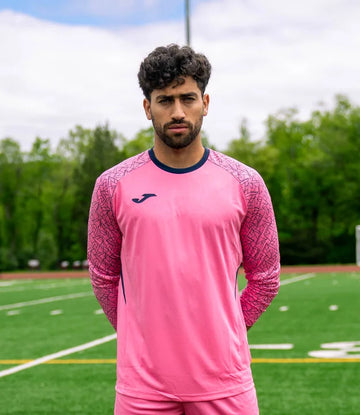
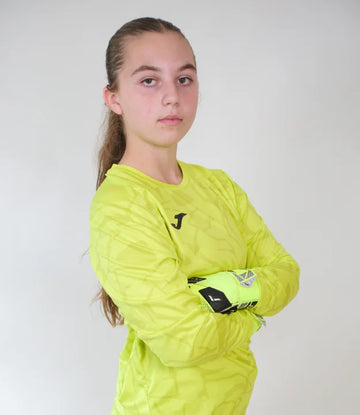
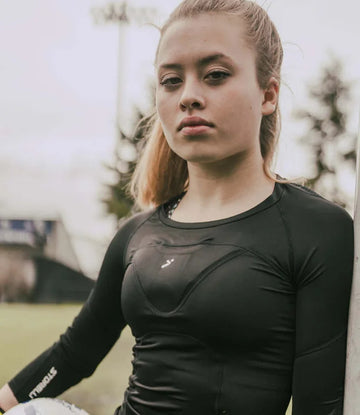
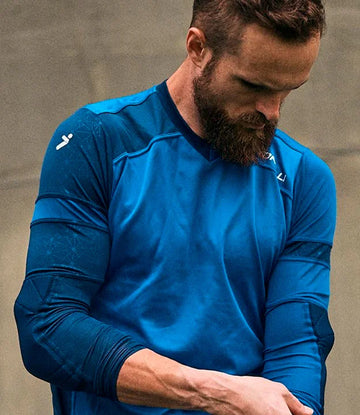
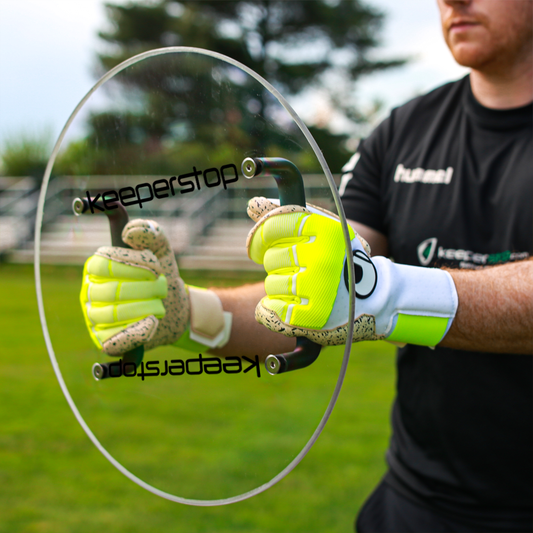
 Gloves
Gloves
 Jerseys
Jerseys
 Gear
Gear
 Brands
Brands
